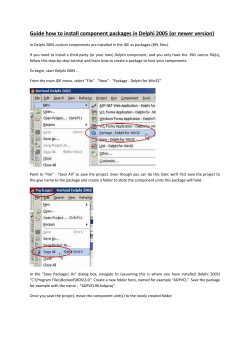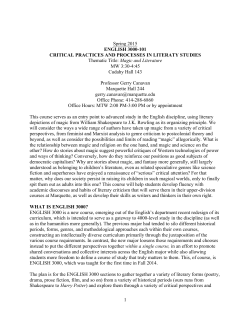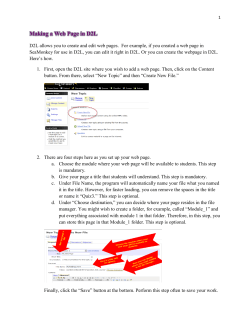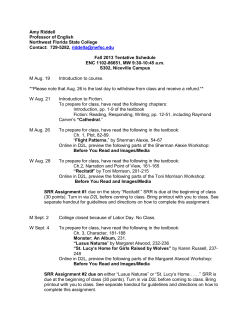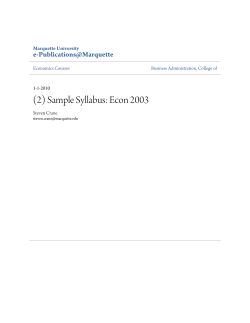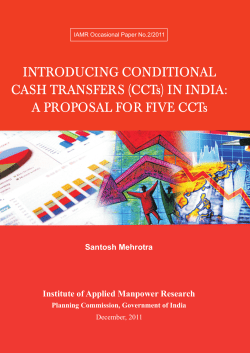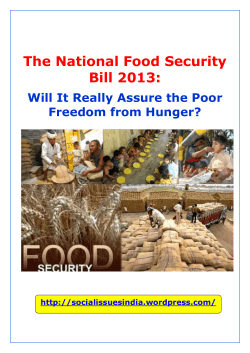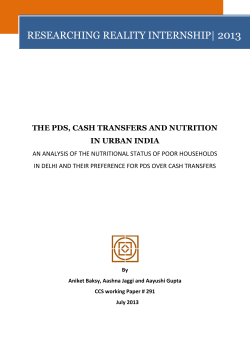
People’s Monitoring of Government Food Schemes A Handbook
People’s Monitoring of Government Food Schemes A Handbook The ‘Right to Food’ Case In April 2001, the People’s Union for Civil Liberties (PUCL, Rajasthan) submitted a writ petition to the Supreme Court of India seeking enforcement of the right to food. The basic argument is that the right to food is an aspect of the fundamental “right to life” enshrined in Article 21 of the Indian Constitution. This public interest litigation (PIL) is known as “PUCL vs. Union of India and Others, Writ Petition (Civil) 196 of 2001”. The judgment is still awaited, but meanwhile, the Supreme Court has issued a series of “interim orders” aimed at safeguarding various aspects of the right to food. These “interim orders” of the Supreme Court are primarily concerned with the existing food and work related schemes of the Governments, both State and Central, converting the benefits of these schemes into legal entitlements. The schemes covered by the orders of the Court are the following: • • • • • • • • • Integrated Child Development Services (ICDS) Mid Day Meal Scheme (MDMS) Targeted Public Distribution System (TPDS) Antodaya Anna Yojana (AAY) National Maternity Benefit Scheme (NMBS) Sampoorna Gramin Rojgar Yojana (SGRY) (now replaced by the National Rural Employment Guarantee Scheme) National Old Age Pension Scheme (NOAPS) National Family Benefit Scheme (NFBS) Annapurna Yojana Commissioners of the Supreme Court The Supreme Court appointed two Commissioners to monitor the compliance with its orders, and also the extent and quality of implementation by state governments of the various food schemes. Dr. N.C.Saxena is the Commissioner and Mr. Harsh Mander is the Special Commissioner. They are assisted by a small group of researchers based in Delhi, who form the ‘Commissioners’ Office’. The Commissioners also have a network of advisors in the various states of the country, who take up state level implementation issues with the state government and also inform the Commissioners on actual functioning of the schemes. The Commissioners can be contacted at: Office of the Commissioners of the Supreme Court (CWP 196/2001) B102 First Floor, Sarvodaya Enclave New Delhi 110017 telephone: 26851335/9 email: commissioners@vsnl.net People’s Monitoring Courts and the law can recognize rights of people, but just by themselves they are not reliable guarantees that people will actually realize those rights. This requires constant vigilance and pressure by people through a range of democratic instruments of resistance. One of these is using the power of information, analysis, monitoring and social audit, in relation to what the government is doing to meet people’s rights and implement its schemes. This applies also to the right to food. This manual is an attempt to equip ordinary people with the tools of continuous monitoring of government food schemes and other interventions to secure the people’s right to food. As implementation problems are key factors behind inefficient functioning of these schemes, there is continuous need to understand the implementation problems to directly feed into the Court proceedings and Government decisions for addressing bottlenecks, and changing where needed the implementation practices and policies. Even independent of the court processes, such monitoring would enable local communities to demand and secure local redressals. It is very clear that strict compliance with the Supreme Court orders would bring farreaching improvement in the food security of the rural poor. However as the noncompliance start at the grassroots levels themselves, it is very difficult for the Court to assess the compliance status and pass further orders to identify and remedy any slackness in implementation and hence secure genuine compliance. Therefore there is urgent need for generating information at field level on the compliance status of the court orders. Using the Handbook This handbook can be used by anyone who is interested in assessing how the food schemes are functioning, especially in relation to the Court orders. It can be used by beneficiaries of the scheme, local community groups, activists, researchers and so on. The questionnaires in this handbook should be addressed to those who are eligible to be beneficiaries of the particular scheme, irrespective of whether they actually receive any benefit. While some of the schemes are to have universal coverage, having a BPL card is a precondition to be eligible for the scheme, in the case of many of the food schemes (details in the scheme-wise sections). However field reports show that there are many problems associated with the identification of BPL families, distribution of BPL cards and so on. Many times it is seen that while the poorest of the poor in the village do not have BPL cards, some of the better off do have them. In such cases, we can also find out if those who are really poor have a card or have benefit from any of these schemes. Identifying Respondents As explained above this handbook is to be used both as a mobilization tool at the village level and also for research purposes. The sampling method to be used would depend on the purpose of the survey. If it is being used to understand the performance of the scheme at the state/district level, the sample size must be adequate. Similarly, in order to assess whether there is a difference in the way in which the scheme is accessible to people belonging to different social categories, care must be taken to ensure that there are adequate respondents belonging to each social category. Analysis The questionnaires are designed in a manner in which not only is the conducting of the survey simple, but the analysis of the data is simple too. For most of the analysis all that we are required to do is calculate simple averages/ percentages. In order to do this for different social categories the averages/percentages for each group must be calculated separately. Follow Up Once the survey has been conducted and the results have been analysed, this data must be shared with the community. If any violation of Supreme Court orders or corruption has been seen in the survey, action must be taken. Action must be taken at the local level first, for instance by bringing it to the notice of the Gram Panchayat. 1 If the survey has been conducted at a large scale (state level) then the results may also be reported to the Commissioners’ Office/State advisors for further action. The Supreme Court has laid out the following grievance redressal mechanism in its order dated 8 May 2002. We must try and activate this system. 1. The Gram Sabhas are entitled to conduct a social audit into all Food/Employment schemes and to report all instances to misuse of funds to the respective implementing authorities, who shall on receipt of such complaints, investigate and taken appropriate action in accordance with law. 2. On a complaint being made to the Chief Executive Officer of the Zilla Panchayat (CEO)/Collector regarding non-compliance of the orders of this Court the Concerned CEO/Collector shall record the salient features of the complaint in a register maintained for this purpose, acknowledge receipt of the complaint and forthwith secure compliance with this Court’s order. 3. The CEO/Collector of all the Districts in the States and territories shall scrutinize the action taken by all the implementing agencies within their jurisdiction to ensure compliance with this court’s orders and report to the Chief Secretary. 4. The responsibility for implementation of the order of this Court shall be that of the CEO/Collector. The Chief Secretary will ensure compliance with the order of this Court. 5. Dr. N.C. Saxena, former Planning Secretary, Government of India, and Mr.S.R. Shankaran, former Secretary, Rural Development, Government of India, shall function as Commissioners of this Court for the purpose of looking into any grievance that my persist after the above-mentioned grievance resolution procedure has been exhausted. 1 See “What we can do” section in the primer on Supreme Court orders: A tool for action 6. On the Commissioner’s recommending a course of action to ensure compliance with this Court’s order, the State Government/UT administrations, shall forthwith act upon such recommendation and report compliance. 7. The Commissioners shall be at liberty to take the assistance of individuals and reliable organizations in the State and Union Territories. All officials are directed to fully cooperate with such persons/organizations, to bring about effective monitoring and implementation of the order of this Court. 8. The Gram Sabhas are empowered to monitor the implementation of the various schemes and have access to relevant information relating to, inter alia, selection of beneficiaries and the disbursement of benefits. The Gram Sabhas can raise their grievance(s) in the manner set out above and the redressal of the grievance (s) shall be done accordingly. Targeted Public Distribution System and Antodaya Anna Yojana Under Targeted Public Distribution System, as far as responsibilities are concerned, there is clearly demarcated role for Government of India and State Governments, whereby Government of India determines the total number of households in each state who are eligible to get the subsidized food grains at BPL and AAY rates and allocates 35 Kg food grain per month to each BPL/ AAY household and the state governments put in place the implementation system to distribute the food grains. While designing the implementation system, the state governments have to strictly follow broad guidelines given by Government of India through the PDS control order 2001 and PDS control order amendment 2 . The State Government may further have their own State PDS Control order and state guidelines, which elaborates the state specific implementation system created to distribute the food grains. For a simpler version of the guidelines one could refer to the TPDS citizens charter in different states, which is supposed to give in simple language all that the government promises to provide under the scheme. Once a clear understanding of the broad responsibilities of the State Government is arrived at, one could start with the analysis of the performance of the State Governments in complying with court orders and implementing the scheme in general. Annapurna is a free grain scheme for the old people above 65 years of age who have been left out of the old age pension scheme. In this scheme, ten kilograms of free grains are given to the beneficiaries each month. Some important Supreme Court Orders related to TPDS and AAY 3 1. The identification of BPL families, issuing of cards and commencement of distribution of 25 kgs. grain per family per month must be completed latest by 1st January, 2002. Note that the entitlements of BPL families were subsequently raised from 25 kg. of grain per month to 35kg. 2. All rations shops must remain open throughout the month, during fixed hours, the details of which will be displayed on the notice board. 3. The licenses of PDS dealers and shop-keepers should be cancelled if they do not keep their shops open throughout the month during the stipulated period; fail to provide grain to BPL families strictly at BPL rates and no higher; keep the cards of BPL households with them; make false entries in the BPL cards; engage in blackmarketing or siphoning away of grains to the open market and hand over such ration shops to such other person/organizations. 4. Arrangements must be made to permit the BPL household to buy the ration in installments. 2 http://fcamin.nic.in/civil_ind.htm For details of the Supreme Court orders in this case, please see “Supreme Court orders: A tool for action” Right to Food Campaign (2005), also available at www.righttofoodindia.org 3 5. 6. The Government of India was directed to place on AAY category the following groups of persons: 1. Aged, infirm, disabled, destitute men and women, pregnant and lactating women, destitute women; 2. Widows and other single women with no regular support; 3. old persons (aged 60 or above) with no regular support and no assured means of subsistence; 4. households with a disabled adult and assured means of subsistence; 5. households where due to old age, lack of physical or mental fitness, social customs, need to care for a disabled, or other reasons, no adult member is available to engage in gainful employment outside the house; 6. primitive tribes. Possession of a BPL card is not necessary for inclusions in the AAY category. Sample For the first part of the survey you can choose any adult member of the village. For the survey results to be reliable, this selection should be conducted randomly. Depending on the purpose of the survey and the availability of time and resources, choose the number of persons who will be interviewed in the village. Since one of the issues related to the PDS is the (mis)identification of families as BPL, we should also try and assess whether those are really poor have been given BPL cards. This can be done for at least five such families selected randomly, and checking whether they indeed have a BPL card. Questionnaire Part I Name of the Person Interviewed:............................................................................... Age:............................................................................................................................ Male/Female: ............................................................................................................. SC/ST/OBC General: ................................................................................................ Name of the Village/Town: ....................................................................................... Block:......................................................................................................................... District: ...................................................................................................................... State: .......................................................................................................................... 1. Do you have a ration card? 1. Yes 2. No 2. If yes, what kind of ration card do you have? 1. BPL 2. Antodaya 3. APL 4. Other 3. What is the quota of foodgrain (rice and wheat) that you can get at the ration shop each month? 1. 35kg. 2. between 26kg. and 34kg. 3. 25kg. 4. less than 25kg. 4. If less than 25kg., specify how many kg. of grain you get? ……….kg. 5. What is the price you pay for: a) One kg of Rice: Rs. ………… b) One kg of Wheat: Rs. ………. 6. How do you rate the quality of food grain you get from the ration shop? 1. Good 2. Average 3. Bad 7. How often was the ration shop open during the last month? 1. Everyday 2. Every alternate day or 3–4 days a week 3. Every week but less than two times a week 4. 2–3 times during the month 5. One day in the month 6. Never 8. Can you buy your month’s quota of grain in more than one installment? 1. Yes 2. No 9. Were you ever denied ration? 1. Yes 2. No 10. Is your ration card with you? 1. Yes 2. No 11. If No, who is it with? 1. Ration dealer 2. Panchayat worker 3. Sarpanch 4. Other Questionnaire Part II Please conduct the following exercises to further assess whether there is corruption in the Public Distribution System and whether the identification of families as being BPL or eligible for AAY has been done in a fair manner Please visit the ration shop in the village and respond to the following questions based on your observations 1. Are the following displayed at the ration shop? a. details of stocks 1. Yes 2. No b. card holders’ names 1. Yes 2. No c. food grain entitlement 1. Yes 2. No d. time of functioning 1. Yes 2. No 2. Randomly check entries against 5 beneficiaries in the distribution register and verify this against the entries in the ration card of these beneficiaries and also ask them whether they actually received the amount that has been mentioned in the distribution register. (Do this for the last month) Based on this exercise, fill in the following table: No. of kgs of grain given according to distribution register No. of kgs of grain received according to ration card entry No. of kgs of grain received according to the beneficiary Person 1 Person 2 Person 3 Person 4 Person 5 Selection of Beneficiaries 1. Randomly select at least five people who are eligible to receive AAY cards and check whether they have really got it Social category Person 1 Person 2 Person 3 Person 4 Person 5 2. AAY card holder Yes/No Yes/No Yes/No Yes/No Yes/No Select at least five poor people in village who you think are poor and find out whether they have BPL cards. No. visited ......................................................................................................... No. having BPL cards ....................................................................................... Analysis of survey results Through this survey we can assess the following: • Whether people are getting the full quota that they are entitled to (35kgs) • Whether people are paying the correct price for the grain or more. The prices for antodaya card holders are Rs. 3 per kg. for rice and Rs. 2 per kg for wheat. The prices for rice and wheat for BPL and APL card holders are different in different states. For this, we must find out what the correct prices are. What people are reporting must then be compared with this. If they report paying higher prices, this indicates corruption. • What the quality of grain is according to people is • Whether other orders of the Supreme Court such as keeping the ration shop everyday and giving rations in installments are being complied with. • Based on the verification of entries in the distribution registers with the actual benefits received according to the people, we can see if there is corruption. Finally, we can also assess whether those who need BPL cards are actually getting them. Integrated Child Development Scheme The ICDS is a complex scheme both for the range of diverse and difficult objectives that the scheme seeks to achieve and the complexity and scale of its implementation. The scheme was started in 1975 with the following objectives: 1. 2. 3. 4. 5. To improve the nutritional and health status of children below the age of six years To lay the foundation for the proper psychological, physical and social development of the child To reduce the incidence of mortality, morbidity, malnutrition and school dropouts. To achieve effective coordination of policy and implementation among various departments to promote child development To enhance the capability of the mother to look after the normal health, nutritional and developmental needs of the child through proper community education. Although the most visible and best known of the services of the ICDS is supplementary nutrition, it provides in fact a range of other services, which are arguably even more vital, and should be monitored as well. The six services covered under the ICDS programme are: 1. 2. 3. 4. 5. 6. Supplementary Nutrition Pre School Education Immunization Referral Services Nutrition and Health Counseling Health check ups Some important Supreme Court Orders related to ICDS 1. Universalize ICDS to cover every habitation, every child under six, every pregnant woman and lactating mother and every adolescent girl 2. Universalize all services of ICDS 3. All SC/ST hamlets should have anganwadis 4. ICDS services should never restricted to BPL families 5. Contractors shall not be used for the supply of SNP 6. ‘Anganwadi on demand’ should be provided within three months in cases where a settlement has at least 40 children under six but no Anganwadi (rural communities and urban slums). Sample The persons interviewed for the ICDS scheme should ideally be mothers of children under six years of age. Again, how many mothers will be interviewed and how they will be selected should be decided considering the purpose of the study and the time/resources available. Questionnaire Part I Name of the Respondent:........................................................................................... Name of the Child:..................................................................................................... Age of the Child:........................................................................................................ Male/ Female (Child):................................................................................................ SC/ST/OBC/ General: ............................................................................................... Name of the Village/Town: ....................................................................................... Block:......................................................................................................................... District: ...................................................................................................................... State: .......................................................................................................................... 1. Is there an AWC in the habitation? 1. Yes 2. No 2. How often is the AWC open? 1. Everyday 2. Once a Week 3. Occasionally 4. Never 3. Is your child enrolled in the anganwadi centre? 1. Yes 2. No 4. Are there any condition/restrictions for getting admission into the anganwadi centre? 1. Yes 2. No 5. If Yes, what is the condition? 1. Only for BPL card holders 2. Only for malnourished children 3. Other (specify) 6. Is your child given food/SNP at the anganwadi that he/she can eat in the centre itself or is it a take-home ration? 1. On-site feeding 2. Take Home Ration 7. How often does your child get food/SNP at/from the anganwadi centre? 1. Everyday 2. Once a week 3. Once in a fortnight 4. Other 8. What is the food that is provided to your child at the anganwadi centre? 1. Hot cooked meal 2. Dalia/panjiri 3. “ready to eat” food 4. Dry rations 9. Has the AWW ever visited you at home? 1. Yes 2. No 10. What in your assessment is the quality of food being provided? 1. Good 2. Average 3. Poor 11. If the child is more than 3 years of age, ask: Are pre-school activities conducted in the anganwadi centre? 1. Yes 2. No 12. How often is your child weighed in the anganwadi centre? 1. Once a month 2. Once in three months 3. Once in six months 4. Never 5. Other 13. If the child was ever weighed, did the anganwadi worker explain to you how well the child is growing? 1. Yes 2. No Questionnaire Part II Please visit the anganwadi centre in the village and respond to the following questions based on your observations and by talking to the anganwadi worker: 1. What kind of a building is the anganwadi centre housed in? 1. Own building 2. Panchayat/other government building 3. Rented house 4. AWW/AWH’s house 2. Is the food provided at the AWW locally procured or is there a contractor? 1. Purchased by Village/ Panchayat/ AWW 2. Supplied from outside 3. Prepared by SHG 3. Does the AWC have the following? a. Drug Kit 1. Yes 2. No b. Weighing Scales 1. Yes 2. No c. Play Equipment 1. Yes 2. No d. Cooking Facilities 1. Yes 2. No e. Drinking water facilities 1. Yes 2. No f. Toilet 1. Yes 2. No 4. If there are separate SC or ST hamlets in the village, is the AWC located there? 1. Yes 2. No 5. Is the anganwadi worker from SC or ST backgrounds? 1. Yes 2. No 6. Was a disability survey conducted by the AWW? 1. Yes 2. No 7. Do any disabled children regularly attend the AWC? 1. Yes 2. No 8. Are any pre-school activities carried out at the AWC? 1. Yes 2. No 9. Do children from all castes made to sit together intermingled? 1. Yes 2. No Analysis of results The results of the survey can be used to assess the following: • Whether all habitations are covered by anganwadi centres • Whether the anganwadi centres are functioning regularly • Whether different services of ICDS are being provided • The quality of services provided • Infrastructure facilities at the anganwadi centres • Aspects of social exclusion Mid-day Meal Scheme The National Programme of Nutritional Support to Primary Education, popularly known as the Mid Day Meal Scheme was launched on August 15, 1995 with the following objectives: 1. 2. To boost universalization of primary education by increasing enrolment, retention and attendance of children attending primary school and To improve (the) nutritional status of students of primary classes 4 Other than the ICDS, the mid day meal scheme is the only other scheme, which targets the nutritional needs of children. Although the scheme is targeted only towards school Government of Indian children, it is nonetheless important and has the advantage of promoting enrolment and preventing children from dropping out of school. The Mid Day Meal Scheme comes under the purview of the Department of Elementary Education and Literacy, under the Ministry of Human Resource Development, Government of India. The scheme is implemented by State Governments. As per directions from the Government of India, State Governments have been directed to identify an appropriate nodal department for the implementation of the MDMS. The departments for the implementation of the MDMS thus differ across States. For instance, the mid day meal is implemented by the Department of Women and Child Development of the Government of Orissa, the Panchayat and Rural Development Department of the Government of Madhya Pradesh and by the Mid Day Meal Department of the Government of Tamil Nadu. Some important Supreme Court Orders related to MDMS 1. Provide every child in every Government and Government assisted Primary Schools with a prepared mid day meal with a minimum content of 300 calories and 8–12 grams of protein each day of school for a minimum of 200 days. Note that the mid-day meal calorie norm has subsequently been raised by the Government of India to 450 calories and 12 grams of protein. 2. In appointment of cooks and helpers, preference should be given to Dalits, Scheduled Castes and Scheduled Tribes. 3. In drought-affected areas, mid-day meal should be supplied even during summer vacations 4. The Central Government was directed to “make provisions for construction of kitchen sheds” and also to contribute to the cooking costs. 5. Attempts shall be made for better infrastructure, improved facilities (safe drinking water etc.), closer monitoring (regular inspection) and other quality safeguards as 4 Department of Elementary Education and Literacy, Annual Report, 2004–2005 also the improvement of the contents of the meal so as to provide nutritious meal to the children of the primary schools. Sample For the mid day meal questionnaire, talk to students of the Government Primary School, preferably to the older children who are able to respond. Questionnaire Part I Name of the Respondent:........................................................................................... Name of the Child:..................................................................................................... Age of the Child:........................................................................................................ Male/ Female (Child):................................................................................................ SC/ST/OBC/ General: ............................................................................................... Name of the Village/Town: ....................................................................................... Block:......................................................................................................................... District: ...................................................................................................................... State: .......................................................................................................................... 1. Is hot cooked meal provided in the school? 1. Yes 2. No 2. Is the meal given sufficient in quantity? 1. Yes 2. No 3. Is the meal given regularly throughout the year on all working days? 1. Yes 2. No 4. If the area is in a drought prone district ask: Is the meal provided during periods of long vacations? 1. Yes 2. No 5. Are different menus served on different days of the week? 1. Yes 2. No 6. Do you bring your own plates and utensils from home? 1. Yes 2. No 7. If not, are the plates provided in the school identical for children of all castes? 1. Yes 2. No 8. If a child asks for a second helping, is he/she given this? 1. Yes 2. No 9. Are children of all castes made to sit together intermingled? 1. Yes 2. No 10. Are children of all castes given the same quality and quantity of food? 1. Yes 2. No Questionnaire Part II Please respond to the following questions by observing the mid-day meal being served and also talking to one of the following—the teacher, VEC member, parent, cook/helper or the village Sarpanch/Adyaksh). 1. Does the school house a source of drinking water? 1. Yes 2. No 2. Whether the cook appointed is a SC or ST? 1. Yes 2. No 3. Are the teachers involved in the organizing/procuring raw materials/cooking of the mid-day meal? 1. Yes 2. No 4. If yes, how much of their time is given for this? 1. Yes 2. No 5. Is the food provided at the school locally processed or is there a contractor or caterer? 1. Locally procured 2. Contractor or caterer 3. Women SHGs 4. Panchayat 5. Other (specify) Analysis of Results The results of the survey can be used to assess the following: • Whether the mid day meal is being provided regularly • Whether there is infrastructure provided • Whether the quality of meal is good • Aspects of social exclusion National Maternity Benefit Scheme/Janani Suraksha Yojana National Maternity Benefit Scheme (NMBS) came into effect as a component of National Social Assistance programme (NSAP) on 15th August 1995. The scheme provides Rs.500 assistance to BPL pregnant women, 8-12 weeks prior to delivery, for each of the first two births. In 2001, under PUCL vs. UOI Civil writ petition 196 of 2001, this scheme was one among the schemes taken by the Supreme Court, whereby implying that the ‘maternity relief” in form of cash assistance worth Rs. 500/-, also has a food security component in it. After 5 years of its inception, in the years 2001–2002 this scheme was transferred from Department of Rural Development to Department of Family Welfare, Ministry of health and family welfare. Some important Supreme Court orders on the NMBS 1. NMBS should be promptly implemented and should not be restricted or discontinued in anyway. 2. The Union of India and all the State Governments and the Union Territories shall (i) continue with the NMBS and (ii) ensure that all BPL pregnant women get cash assistance 8–12 weeks prior to the delivery. 3. The amount shall be Rs.500/- per birth irrespective of number of children and the age of the women. 4. The benefits of the scheme should be regularly advertised. Note: The NMBS was merged into the Janani Suraksha Yojana (JSY), a scheme for promoting institutional deliveries which was introduced by the government of India in 2005. While in principle, the benefits of the NMBS remained in the newly modified JSY, this caused a lot of confusion on the ground with the objectives of the two schemes being different. While the objective of NMBS was to provide nutrition support during pregnancy, the objective of JSY was to give incentives for women to have an institutional delivery. As a result many women who were eligible for benefit under NMBS and had a home delivery were not getting any benefit. The Supreme Court in its order dated 20 November 2007 clarified that the NMBS must continue and an amount of Rs. 500/should be paid irrespective of number of children and age of women, 8–12 weeks prior to delivery. Sample To assess the performance of the NMBS scheme we must talk to women who are currently pregnant or who had a delivery in the recent past (last one year). Questionnaire Name of the Respondent:........................................................................................... Age:............................................................................................................................ Male/ Female: ............................................................................................................ SC/ST/OBC/ General: ............................................................................................... Name of the Village/Town: ....................................................................................... Block:......................................................................................................................... District: ...................................................................................................................... State: .......................................................................................................................... 1. Are you a BPL card holder? 1. Yes 2. No 2. Did you apply for benefit under the NMBS/JSY? 1. Yes 2. No 3. If Yes, When did you apply? 1. First Trimester of pregnancy 2. Second Trimester of pregnancy 3. Third Trimester of pregnancy 4. After delivery 4. Where did you deliver? 1. At home 2. Institution 5. How many children do you have? 1. One 2. Two 3. Three 4. More than three (specify) 6. Were you paid any amount under the scheme? (Note: If benefit was paid ask questions 7 to 12, if No, then go to question no. 13) 1. Yes 2. No 7. If Yes, how much money were you given? 1. Rs. 500/2. More than Rs. 500/3. Less than Rs. 500/- 8. Were you given the entire amount at one time? 1. Yes 2. No 9. When were you given the money (if given in more than one installment, when was the first payment made?) 1. During pregnancy 2. Immediately after delivery 3. Much after delivery 10. Did you have to provide any documents for getting the benefit? 1. Yes 2. No 11. If yes, what did you have to show? 1. BPL card 2. Age certificate 3. Other 12. What was this money spent on? 1. Food for yourself 2. Medical care for self 3. Nothing specific, included in the family pool 13. If benefit was not given, why were you refused? 1. Not BPL 2. More than two children 3. Less than 19 years 4. Had a home delivery 5. Other Analysis of results The results of the survey can be used to assess the following: • Whether eligible beneficiaries are getting benefit • Whether those having home deliveries are being discriminated against • Whether the women are getting the entire amount that they are entitled to • Whether any other restrictions such as no. of children, age etc. are being placed • Whether the benefit is being used by the women themselves National Old Age Pension Scheme and Annapurna National Social Assistance Programme (NSAP) was initiated in August 1995 and since then has undergone many changes in its design. The present structure of NSAP includes National Old Age Pension Scheme (NOAPS) and National Family Benefit Scheme (NFBS), which are implemented along with the Annapurna Scheme. This is a very critical programme as most of the starvation deaths are either of infants or aged people from very poor families or without care givers. NOAPS is a monthly pension scheme for the aged destitute. NOAPS has recently been modified into the Indira Gandhi National Old Age Pension Scheme under which ALL old people above 65 years of age (BPL) are eligible for pension and the pension amount has been raised to Rs. 400 per month. Annapurna provides food grains on a monthly basis to the aged poor to ensure their food security. It is objectively meant for “those senior citizens who though eligible have remained uncovered under the National Old Age Pension Scheme”. Some important Supreme Court orders on NOAPS and Annapurna 1. State governments have been directed to complete the identification of persons entitled to pensions under NOAPS, and to ensure that the pensions are paid regularly. 2. Payment of pensions is to be made by the 7th day of each month. 3. Both the schemes must not be discontinued or restricted without the permission of the Supreme Court. 4. The NOAPS grants paid by the Central Government to the State Governments under “Additional Central Assistance” should not be diverted for any other purposes. 5. Annapurna should also be promptly implemented. Sample To understand the implementation of these schemes, talk to old people (above 65 years) who are BPL/Antodaya card holders Questionnaire Name of the Respondent:........................................................................................... Age:............................................................................................................................ Male/ Female: ............................................................................................................ SC/ST/OBC/ General: ............................................................................................... Name of the Village/Town: ....................................................................................... Block:......................................................................................................................... District: ...................................................................................................................... State: .......................................................................................................................... 1. Are you a beneficiary of the old age pension scheme? 1. Yes 2. No 2. If no, ask: Are you a beneficiary of the Annapurna scheme? (Note: For pension beneficiary ask questions 3 to 7, If Annapurna ask questions 8 to 10. Ask all Respondents question no. 11. Finally, those who are not beneficiaries of either of the schemes ask question no. 12 and 13) 1. Yes 2. No 3. If pension, How much pension are you given, each month? 1. Rs. 100/2. Rs. 150/3. Rs. 200/4. More than Rs. 200/5. Other 4. Do you have to pay anything to be selected or to receive the pension (or is any amount cut from your payment?) 1. Yes 2. No 5. Do you get the pension regularly every month? 1. Yes, in first week of a month 2. Yes, but not in first week of the month 3. No, it is irregular 6. Do you face any of the following difficulties in getting and using the pension? a. Have to travel a long distance to get pension 1. Yes 2. No b. Apathy of officials 1. Yes 2. No c. Corruption/ have to pay a bribe 1. Yes 2. No d. Family members take away the money 1. Yes 2. No e. Other (specify) 7. Is the pension amount enough to satisfy your food needs for the whole month 1. Yes 2. No 8. If person receiving Annapurna, do you get the grain every month? 1. Yes 2. No 9. How much grain do you get? 1. 10 kg. 2. less than 10kg. 10. Do you have to pay anything for it? 1. Yes 2. No 11. Which do you think is better? 1. getting free grain 2. getting pension 12. If eligible but not selected, did you apply for the scheme? 1. Yes 2. No 13. What or who in your opinion has blocked your access to the scheme? 1. Sarpanch; 2. Govt officials; 3. Others (specify) Analysis of results The results of this survey can be used to assess the following: • Whether all eligible old people are getting pension • Whether the pension is being paid regularly • What the difficulties faced by pensioners are • What the problems in implementation are • Whether there is any corruption in the scheme National Family Benefit Scheme NFBS is a one-time relief of Rs. 10,000/- to the family that has lost the primary bread winner within four weeks through a local Sarpanch. Some important Supreme Court orders on the National Family Benefit Scheme 1. BPL families are to be paid Rs. 10,000/- within four weeks through the local Sarpanch when the breadwinner dies. 2. As with NOAPS, this scheme is not to be discontinued or restricted in any way without the permission of the Supreme Court. Sample This questionnaire should be addressed to members of family (holding a BPL card) who lost its primary breadwinner in the last five years. Questionnaire Name of the Respondent:........................................................................................... Age:............................................................................................................................ Male/ Female: ............................................................................................................ SC/ST/OBC/ General: ............................................................................................... Name of the Village/Town: ....................................................................................... Block:......................................................................................................................... District: ...................................................................................................................... State: .......................................................................................................................... 1. Did the primary earning member in your family die during the last five years? 1. Yes 2. No 2. Are you a BPL card holder? 1. Yes 2. No 3. How was the person who died related to you? ................................................. 4. Did you apply for assistance under the NFBS? 1. Yes 2. No 5. Did you get any benefit under this scheme? Note: If yes, benefit was given, ask questions 6 to 9. If no, benefit not given ask question 10) 1. Yes 2. No 6. If yes, how much was given? 1. Rs.10,000/2. Less than Rs. 10,000/3. More than Rs. 10,000/- 7. How long after the death you get the payment? ……….Yrs……..months……….days 8. Did you have to pay any bribe to get the benefit? 9. Did you face any other difficulties in getting the benefit? 1. Difficulty in giving required documentary proof 2. No problems faced 3. Other (specify) 10. If you did not get benefit, what in your opinion has blocked your access to the scheme? 1. Did not fulfil eligibility criteria 2. Eligible, but could not provide documents necessary 3. Eligible, but could not pay bribe 4. Other (specify) Analysis of Results The results of the above survey can help in assessing some of the following: • Whether eligible beneficiaries are getting benefit under this scheme • What the difficulties faced in implementation are • Whether there is any corruption National Rural Employment Guarantee Act The National Rural Employment Guarantee Act guarantees a minimum of 100 days of employment to each rural household, whose adult members are willing to do unskilled manual work, at the state minimum wage. NREGA aims to enhance livelihood security in rural areas. Further, the objectives of the Act include developing sustainable assets, empowering rural women, mitigating rural-urban migration and fostering social equity, among others. The act received the President assent on September 5, 2005, and was launched countrywide on February 2, 2006. From this year onwards the scheme has been extended to all the districts in the country. Sample This questionnaire can be addressed to any adult resident of the village Questionnaire Part I Name of the Respondent:........................................................................................... Age: ............................................................................................................................ Male/ Female: ............................................................................................................ SC/ST/OBC/ General: ............................................................................................... Name of the Village/Town: ....................................................................................... Block:......................................................................................................................... District: ...................................................................................................................... State: .......................................................................................................................... 1. Do you have a job card? 1. Yes 2. No 2. Are you aware that you are supposed to demand for work under NREGA? 1. Yes 2. No 3. Did you demand for work under the NREGA? 1. Yes 2. No 4. If yes, did you get work within 15 days? 1. Yes 2. No 5. If no, were you paid an unemployment allowance? 1. Yes 2. No 6. Were you paid piece rate or daily wage? 1. Daily Wage 2. Piece Rate 7. How many days did you work in the last one year?............days 8. How much wages were you paid in total? Rs……….. 9. Were you paid the minimum wage? (Note for investigator: Please find out what the minimum wage in the area is before conducting the survey) 1. Yes 2. No 10. When were you paid wages? 1. Within a week of completing the work 2. Within a fortnight of completing the work 3. Two weeks- One month after completing the work 4. 1–2 months after completing the work 5. More than two months after completing the work 11. Are you content with the number of days of work you got under NREGA? 1. Yes 2. No 12. At the worksite, do you sign the attendance everyday? 1. Yes 2. No 13. If yes, then where is the attendance registered? 1. Muster Roll 2. Register/notebook 3. Piece of paper 4. Other (specify) 14. Do you know of any family that stayed back in the village (and not migrated) because work being available under the NREGA? 1. Yes 2. No 15. If you hadn’t got the work under NREGA what would you have done? 1. Migrated to a different place in search of work 2. Other (specify) Questionnaire Part II If there is a worksite in the village, please respond to the following questions based on your observations at the worksite: 1. Were machines like tractors being used for the works? (If need be, check with the respondents/workers working at the site, if machines were used previously) 1. Yes 2. No 2. Is there provision of drinking water at the worksite? 1. Yes 2. No 3. Is there a provision of shade at the respective worksite? 1. Yes 2. No 4. Is there any provision for young children (under the age of six) accompanying their mothers at the worksite and a crèche? 1. Yes 2. No 5. Are contractors involved in implementing the work? 1. Yes 2. No 6. How many disabled people have been employed out of the total workforce at the worksite? ………… (If need be, check with the respondents/workers working at the site, if any disabled individuals were employed at the worksite) Analysis of Results The data generated from the results of the above survey can throw light on the following: • • • • • Whether people are aware that they have a right to demand for work Whether those who are demanding for work are indeed being given work Whether minimum wages are being paid and whether wages are being paid in time Some indication of corruption in the scheme Whether there are worksite facilities
© Copyright 2025
